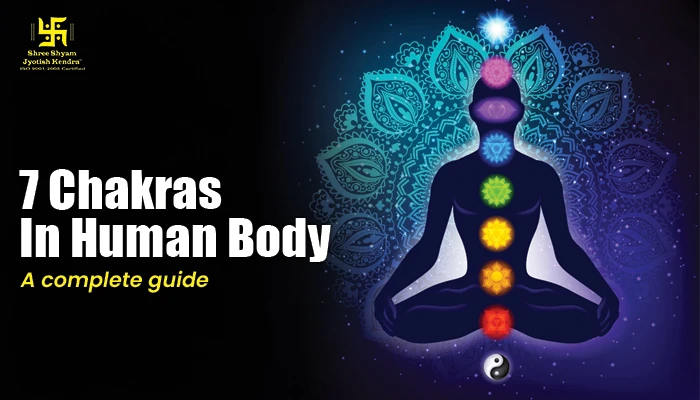
What Are Chakras?
In ancient Indian belief systems, chakras are the energy centers of the human body. The word “chakra” comes from Sanskrit, meaning “wheel” or “disk.” These spinning wheels of energy are believed to connect the physical, emotional, and spiritual parts of our lives.Just like our body has organs, chakras are considered as spiritual organs. There are 7 major chakras, and each one is linked with a specific part of the body and has its own energy purpose.
Understanding these chakras is essential to maintain balance, health, and peace in life.
The 7 Chakras in Human Body
Root Chakra (Muladhara)
- Location: Base of the spine
- Color: Red
- Element: Earth
- Purpose: Stability, safety, survival
- Blocked by: Fear, insecurity, trauma
Sacral Chakra (Svadhisthana)
- Location: Lower abdomen
- Color: Orange
- Element: Water
- Purpose: Creativity, emotions, sexuality
- Blocked by: Guilt, shame
Also check out our thoughts on How to Wear Rudraksha

Solar Plexus Chakra (Manipura)
- Location: Upper abdomen
- Color: Yellow
- Element: Fire
- Purpose: Power, confidence, self-esteem
- Blocked by: Shame, lack of control
Heart Chakra (Anahata)
- Location: Center of the chest
- Color: Green
- Element: Air
- Purpose: Love, compassion, kindness
- Blocked by: Grief, betrayal
Throat Chakra (Vishuddha)
- Location: Throat
- Color: Blue
- Element: Ether (Space)
- Purpose: Communication, truth, self-expression
- Blocked by: Lies, fear of speaking
Third Eye Chakra (Ajna)
- Location: Between the eyebrows
- Color: Indigo
- Element: Light
- Purpose: Intuition, vision, wisdom
- Blocked by: Illusions, doubt
Crown Chakra (Sahasrara)
- Location: Top of the head
- Color: Violet or white
- Element: Cosmic Energy
- Purpose: Spiritual connection, enlightenment
- Blocked by: Ego, attachment
Significance of the 7 Chakras
The 7 chakras are not just energy points—they shape our daily life, emotions, thoughts, and actions. Here’s why they matter:- Mind-body balance: Chakras help align the mind and body.
- Emotional stability: A balanced chakra system keeps your mood steady.
- Health & vitality: Blocked chakras can cause physical discomfort or emotional stress.
- Spiritual growth: They help in connecting with higher consciousness and self-awareness.
Chakras and Astrology: What’s the Connection?
In Vedic astrology, planets are also connected to chakras. Here’s how:|
Chakra |
Planet |
Associated Trait |
|
Root Chakra |
Mars |
Strength, survival |
|
Sacral Chakra |
Venus |
Pleasure, creativity |
|
Solar Plexus |
Sun |
Confidence, leadership |
|
Heart Chakra |
Moon |
Emotions, compassion |
|
Throat Chakra |
Mercury |
Communication, clarity |
|
Third Eye |
Jupiter |
Wisdom, insight |
|
Crown Chakra |
Saturn/Ketu |
Detachment, spirituality |
Signs of Blocked or Unbalanced Chakras
Here are some common signs when your chakras are not in balance:- Fatigue or low energy
- Lack of focus or confusion
- Emotional ups and downs
- Health issues in certain body parts
- Feeling disconnected from life or people
How to Balance Chakras?
Balancing chakras doesn’t always need complex rituals. Simple daily practices help too:- Meditation & deep breathing
- Chanting mantras (e.g., “Lam” for Root, “Vam” for Sacral)
- Using crystals and essential oils
- Yoga poses like Tree Pose, Cobra, or Child’s Pose
- Astrological consultation to know which planetary energy is weak

Conclusion: Healing Through Chakras
The 7 chakras are like the inner GPS of our body. When they are clear and open, we feel healthy, happy, and whole. But when they’re blocked, life feels stuck.Understanding your chakras is not just spiritual—it’s practical too. By knowing how energy flows in your body and what blocks it, you can lead a more balanced and joyful life.
If you’re facing emotional struggles, health issues, or spiritual confusion, it might be time to check your chakra health and planetary influences.
Book a Consultation with Pt. Pawan Kaushik
For personalized chakra balancing and Vedic astrology guidance, you can consult Pt. Pawan Kaushik, a renowned Vastu consultant in India and one of the best astrologers in India. With decades of experience, he blends chakra knowledge and astrology to help people lead better lives.- Discover your planetary influences
- Heal your energy blocks
- Restore balance in mind, body, and soul
 +91 9990176000
+91 9990176000 +91 9999097600
+91 9999097600
 CALENDAR 2025
CALENDAR 2025











